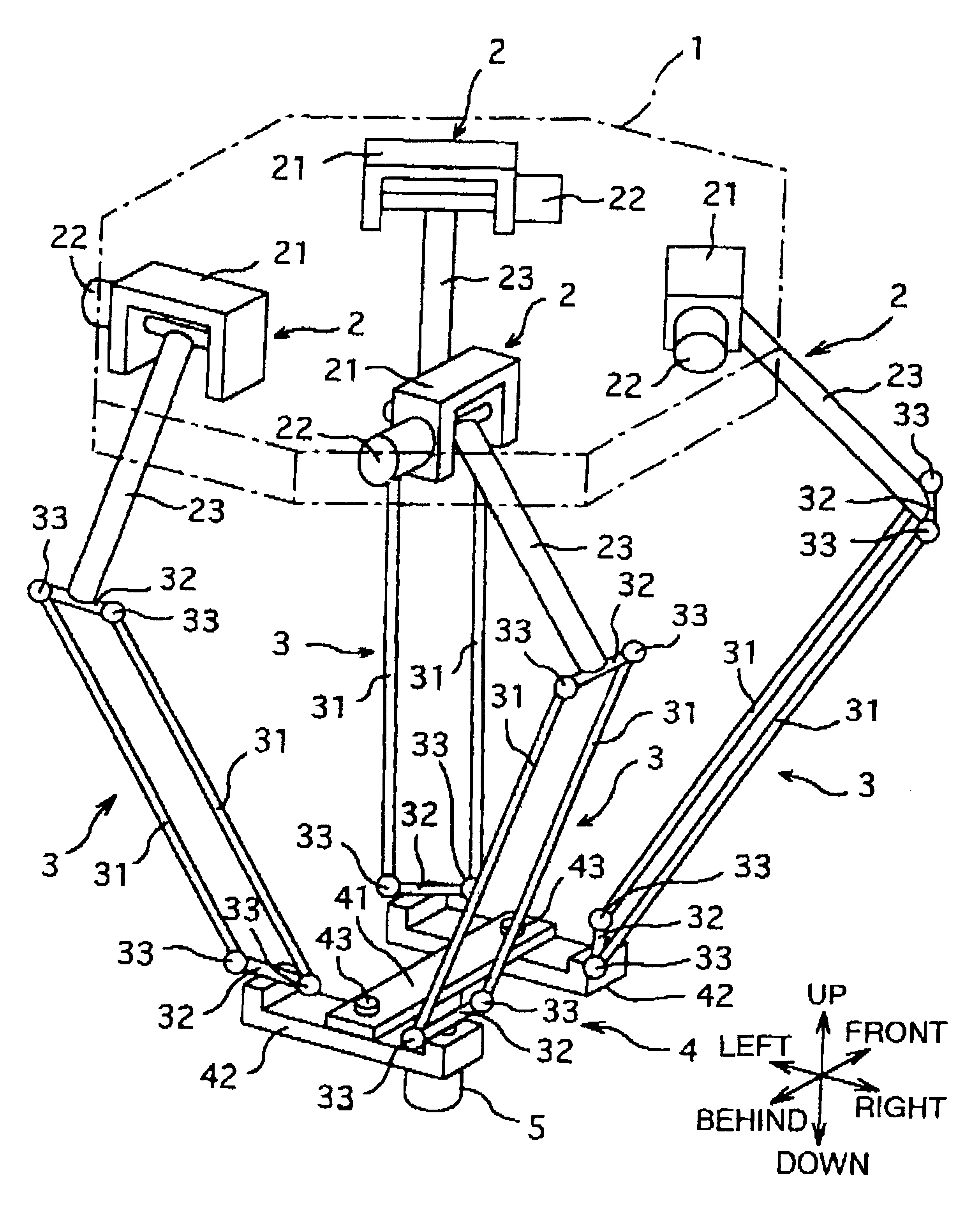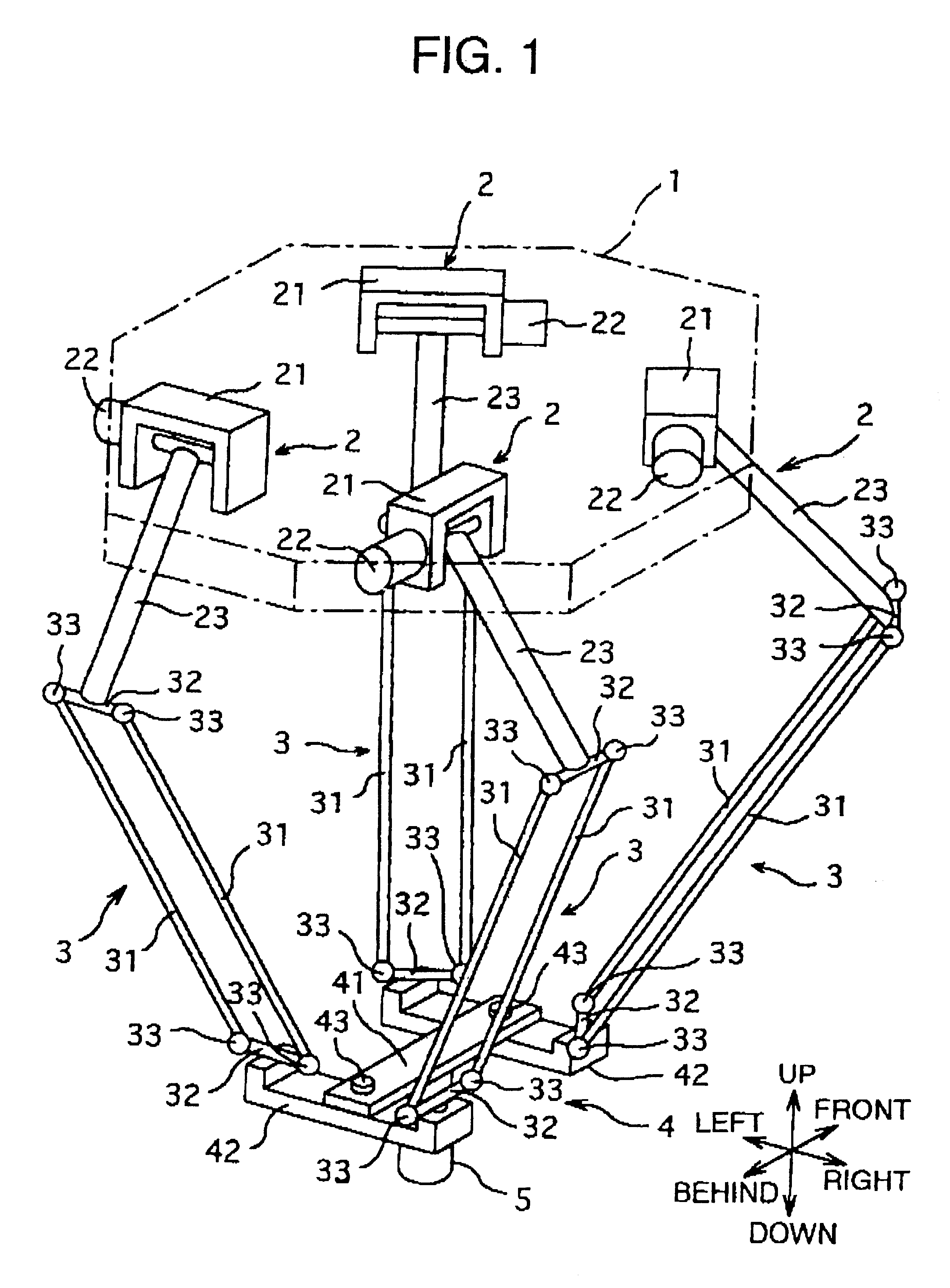Four-degree-of-freedom parallel robot
- Summary
- Abstract
- Description
- Claims
- Application Information
AI Technical Summary
Problems solved by technology
Method used
Image
Examples
embodiment i
of Embodiment I)
As a modification example I of this embodiment, it is possible to realize a four-degree-of-freedom parallel robot which is different from the embodiment I in combination of mounting angles of the actuators 2 and the parallel linkages 3 to the base 1 and the traveling plate 4.
In this modification example, directions of the parallel linkages 3 are coupled to the four corners of the traveling plate 4 can be combined as will be described below. That is, assuming a predetermined direction as a reference direction around the vertical axis which is an axis of rotational motion, the following combinations are possible in one rotational direction. In this case, the mounting angles of the parallel linkages 3 are mounting angles of the end members 32 at lower ends of the four parallel linkages 3 with respect to the traveling plate 4. It is recommended to refer to these mounting angles in conjunction with FIG. 3.
That is, mounting angles of the parallel linkages 3 in this modific...
modification example ii of embodiment i
(Modification Example II of Embodiment I)
As a modification example II of this embodiment, as shown in FIG. 10, it is possible to realize a four-degree-of-freedom parallel robot which has four linear motors 2' as actuators in place of the four rotational motors 22 of the embodiment I. The linear motors 2' serving as actuators are secured to two bases (not shown). Rails of the linear motors 2' are secured at upper end portions to one of the bases, and at lower end portions to the other base.
Each of the linear motors 2' is composed of a vertically extending long rail which is alternately magnetized and a slider which moves along the rail and into which an electromagnetic coil is built. The end member 32 at the upper end of the parallel linkage 3 is fixed to each slider at a predetermined angle. The rails of the four linear motors 2' extend vertically and are disposed in parallel with one another.
Therefore, due to the operation of the linear motors 2', the end members 32 at the upper en...
modification example iii of embodiment i
(Modification Example III of Embodiment I)
As a modification example III of this embodiment, as shown in FIG. 11, it is possible to realize a four-degree-of-freedom parallel robot which has two linear motors 2' as actuators in place of the four rotational motors 22 of the embodiment I. Unlike the aforementioned modification example II, this modification example employs two linear motors 2' whose rails are disposed horizontally in parallel with one another. Although not shown, two bases are provided to secure the linear motors 2' serving actuators. Rails of the linear motors 2' are secured at both ends to the bases.
Each of the linear motors 2' is composed of a horizontally extending long rail which is alternately magnetized and a pair of sliders which move along the rail and into which electromagnetic coils are built. The end members 32 at upper ends of the parallel linkages 3 are fixed to the sliders at predetermined angles. The two rails of the linear motors 2' extend horizontally a...
PUM
 Login to View More
Login to View More Abstract
Description
Claims
Application Information
 Login to View More
Login to View More - R&D
- Intellectual Property
- Life Sciences
- Materials
- Tech Scout
- Unparalleled Data Quality
- Higher Quality Content
- 60% Fewer Hallucinations
Browse by: Latest US Patents, China's latest patents, Technical Efficacy Thesaurus, Application Domain, Technology Topic, Popular Technical Reports.
© 2025 PatSnap. All rights reserved.Legal|Privacy policy|Modern Slavery Act Transparency Statement|Sitemap|About US| Contact US: help@patsnap.com



